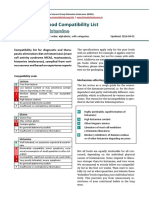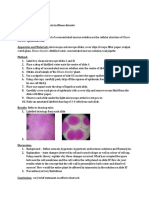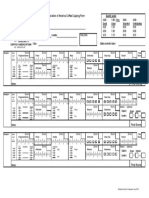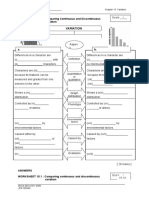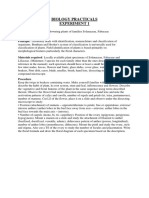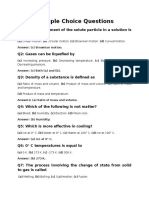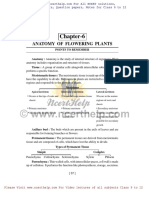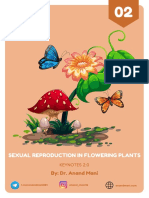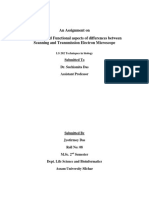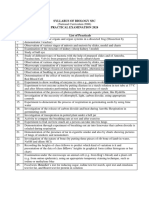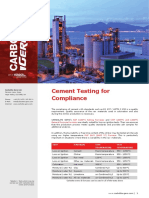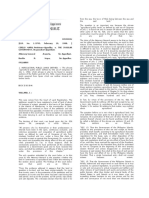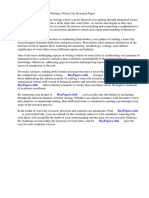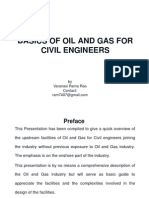Professional Documents
Culture Documents
PRACTICAL Biology 9th & 10th
PRACTICAL Biology 9th & 10th
Uploaded by
nbacademy0 ratings0% found this document useful (0 votes)
5K views3 pagesThis document lists 50 practical experiments for 9th and 10th grade biology classes. It includes experiments on observing bacteria, plant and animal cells under a microscope, studying plant and animal tissues, investigating processes like photosynthesis, respiration, enzyme action, seed germination and more. Many experiments involve dissection of specimens like frogs, examination of plant structures, testing food samples, studying human physiology aspects like pulse rate, and small investigations of ecosystems. The practical experiments cover a wide range of topics from cells to systems.
Original Description:
Copyright
© © All Rights Reserved
Available Formats
PDF, TXT or read online from Scribd
Share this document
Did you find this document useful?
Is this content inappropriate?
Report this DocumentThis document lists 50 practical experiments for 9th and 10th grade biology classes. It includes experiments on observing bacteria, plant and animal cells under a microscope, studying plant and animal tissues, investigating processes like photosynthesis, respiration, enzyme action, seed germination and more. Many experiments involve dissection of specimens like frogs, examination of plant structures, testing food samples, studying human physiology aspects like pulse rate, and small investigations of ecosystems. The practical experiments cover a wide range of topics from cells to systems.
Copyright:
© All Rights Reserved
Available Formats
Download as PDF, TXT or read online from Scribd
Download as pdf or txt
0 ratings0% found this document useful (0 votes)
5K views3 pagesPRACTICAL Biology 9th & 10th
PRACTICAL Biology 9th & 10th
Uploaded by
nbacademyThis document lists 50 practical experiments for 9th and 10th grade biology classes. It includes experiments on observing bacteria, plant and animal cells under a microscope, studying plant and animal tissues, investigating processes like photosynthesis, respiration, enzyme action, seed germination and more. Many experiments involve dissection of specimens like frogs, examination of plant structures, testing food samples, studying human physiology aspects like pulse rate, and small investigations of ecosystems. The practical experiments cover a wide range of topics from cells to systems.
Copyright:
© All Rights Reserved
Available Formats
Download as PDF, TXT or read online from Scribd
Download as pdf or txt
You are on page 1of 3
SAIM ACADEMY BAHAWALPUR
Practical list for 9th Class
(Biology)
1. (a) Study of different types of bacteria with the help of prepared slides
(b) Study of Paramecium
(c) Study of Volvox
2. Part 1: Study of external morphology of Brassica campestris (mustard plant)
Part 2: Microscopic examination of Brassica root, stem and leaf
Part 3: Study of the flower, fruit and seed of Brassica
3. Identification of major organs and organ systems in a dissected frog (dissection by
demonstrator/teacher).
4. Recognition of different animals and plants from fresh and preserved specimens on
the basis of apparent distinguishing taxonomic characters.
5. Evaluation of graphs of a population of an insect (endangered due to excessive use of
insecticides) and interpret the reasons for its endangered status.
6. Use of microscope to observe the movement of small objects
7. Microscopic examination of an animal cell (e.g. from frog’s blood) and a plant cell
(e.g. from onion epidermis) using an appropriate temporary techniques as iodine or
methylene blue.
Part-1: Study of animal cell
Part 2: Study of plant cell
8. Identification of different parts of the cell from fresh preparations.
9. Preparation of wet mounts of tissue from flowering plants and study of plant and
animal tissues from charts and prepared slides.
Part-1: Preparation of wet mounts of tissue from flowering plants.
Part-2: Study of plant and animals tissues from charts and prepared slides.
10. Determination of the effect of tonicity on plasmolysis and deplasmolysis in plant cells
or in red blood cells.
11. Data collection on the number of stomata per unit area on various plant leaves that
grow in areas of differing humidity and completion of data and ‘graph it to determine
the relationship between the variables.
12. Observation of various stages of mitosis and meiosis by slides, models and charts.
Part 1: Study of Mitosis
Part 2: Study of Meiosis
www.ilmiservices.com. Download Free PDF Notes, Guess, Past Papers
13. Preparation of root tip squashes and study of the stage of mitosis.
14. To demonstrate working of an enzyme in vitro e.g. Pepsin working on meat/albumin
in test tube.
15. Experiment to test enzyme action by putting diastase in a starch solution in test tube at
37oC and after 15min performing iodine test for presence of starch.
16. To demonstrate the process of photosynthesis using aquatic plant like Hydrilla.
17. Identification and labeling of the cellular and tissue structures in the cross section
(CS) of a leaf through observations under the microscope.
18. To investigate the necessity of chlorophyll, light and carbon dioxide for
photosynthesis.
19. To demonstrate the process of respiration in germinating seeds by using lime water.
20. To investigate the release of Carbon dioxide and heat during aerobic respiration in
germinating seeds.
21. Food tests:Benedict’s test for glucose (reducing sugar), Iodine test for starch (non-
reducing sugars), spot test and emulsion test for fats, biuret test for protein.
22. Microscopic examination of a transfer section of the small intestine to show villi.
23. Measurement of difference in length/weight of raw potato strips in salt solutions and
in water.
24. Observation of root hairs on growing roots of onion, carrot etc.
25. Microscopic observation of the structure and number of stomata in the epidermal peel
of a leaf.
26. To investigate the rate of water loss at the two surfaces of a leaf by using cobalt
chloride paper.
27. To investigate transpiration in potted plant under a bell Jar.
28. Identification of xylem and phloem tissues in the prepared slides of stem, root and
leaf.
29. To investigate the pathway of water in parts of plants using a suitable stain and
compare sizes of various types of cells
30. Identification of red and white blood cells from prepared slides under microscope and
in photomicrographs.
31. To investigate the effect of physical activity on pulse rate.
32. To observe the capillary flow in a fish tail or fin or frog’s web.
www.ilmiservices.com. Download Free PDF Notes, Guess, Past Papers
Practical list for 10th Class
33. Activity to compare the breathing rate at rest and after exercise.
34. Experiment to find out how much air a person can take into his/ her lungs.
35. Demonstration of the presence of carbon dioxide in the exhaled air.
36. Demonstration of the presence of tar in cigarette smoke and also show by charts and
pictures the difference of lungs of smokers and non smokers.
37. Examination of the structure of the Kidney (Sheep kidney / model)
38. Observation and recording of the difference in quickness of response of the two types
of co-ordination (by asking a student to say few words in front of class and observe
the changes in heart beat).
39. Experiment to observe the contraction in the shin muscle of frog in a petri dish filled
with methylene blue and using 12V DC current.
40. Identify the different parts and draw a labeled diagram of longitudinal section of eye
of a sheep or a bull.
41. Investigation of the nature of bone (by putting three pieces of the bone of lamb in
water, NaOH and dilute HCl).
42. Observation of Binary fission in Amoeba by using slides, photomicrographs and
charts.
43. Observation of Budding in yeast from prepared slides.
44. Examination of a bulb (onion), corm (Colocassia), rhizome (ginger) and stem tuber
(potato) and their cultivation to get new plants.
(a) Bulb of onion
(b) Corm of Colocassia
(c) Rhizome of Ginger
(d) Stem tuber of potato
45. Propagation by stem cuttings (rose or any locally available plant) and Bryophyllum
leaf
46. Examination of mustard flower, gram seed and maize grain.
a. Examination of mustard flower
b. Examination of gram seed and maize grain
47. Investigation of the conditions for seed germination.
48. Recording the heights of class fellows to predict which kind of variation is it and
presentation of the data of class fellows’ heights in graphical form (either histogram
or bar chart).
49. Investigation of an ecosystem e.g., an aquarium or a pond.
50. Investigation about the role of yeast and bacteria in the fermentation of flour and
milk.
a. Fermentation of Milk.
b. Fermentation of Flour
www.ilmiservices.com. Download Free PDF Notes, Guess, Past Papers
You might also like
- Agr 182 Case Study Nur Sofea Alanis BT ZulkifliDocument8 pagesAgr 182 Case Study Nur Sofea Alanis BT ZulkifliNur Sofea AlanisNoch keine Bewertungen
- Lista Alimente Intoleranta La Histamina-1-10 PDFDocument10 pagesLista Alimente Intoleranta La Histamina-1-10 PDFflorentinaNoch keine Bewertungen
- Biology Practical 2Document8 pagesBiology Practical 2N.THEVANoch keine Bewertungen
- CSEC 2. Osmosis1-PlasmolysisDocument1 pageCSEC 2. Osmosis1-Plasmolysisamanda whipple100% (1)
- Biology Practical Food TestDocument1 pageBiology Practical Food TestCHANDREN ARUMUGAMNoch keine Bewertungen
- S.1 Bio Notes PDFDocument57 pagesS.1 Bio Notes PDFkitderoger_391648570100% (4)
- Scaa Cupping FormDocument1 pageScaa Cupping FormAguz SetiawanNoch keine Bewertungen
- Design of 38 Mega Watts Steam Power Plant in Majayjay LagunaDocument232 pagesDesign of 38 Mega Watts Steam Power Plant in Majayjay LagunaPfeona Pfeona100% (1)
- BIOLOGY PRACTICAL (First Term Class 9)Document4 pagesBIOLOGY PRACTICAL (First Term Class 9)hgnsdghagnasvNoch keine Bewertungen
- Physics Practical 1 PDFDocument6 pagesPhysics Practical 1 PDFMohiniraj DangeNoch keine Bewertungen
- Biology Practical NotebookDocument38 pagesBiology Practical Notebookabdulmalik sani100% (1)
- Biology CBSE Practicals Class 10thDocument6 pagesBiology CBSE Practicals Class 10thstudioschilldudesNoch keine Bewertungen
- Compound MicroscopesDocument5 pagesCompound MicroscopesJaybert Merculio Del ValleNoch keine Bewertungen
- NEET PPT Biology SyllabusDocument7 pagesNEET PPT Biology Syllabusjyotisharma20577Noch keine Bewertungen
- Olevel Biology Practical PDFDocument32 pagesOlevel Biology Practical PDFJuma mnandiNoch keine Bewertungen
- Practical 1 MicroscopeDocument8 pagesPractical 1 Microscopeaqilahk100% (7)
- To Prepare Stained Temporary Mounts of Onion Peel and To Record Observations and Draw LabelledDocument2 pagesTo Prepare Stained Temporary Mounts of Onion Peel and To Record Observations and Draw LabelledAnirudhNoch keine Bewertungen
- Sexual Reproduction in Flowering Plants For Class 12 Chapter 2 Biology NotesDocument12 pagesSexual Reproduction in Flowering Plants For Class 12 Chapter 2 Biology Notesharshuvish009Noch keine Bewertungen
- UCTO-Sample-Papers-for-Class-6 CriticalthinkingDocument4 pagesUCTO-Sample-Papers-for-Class-6 CriticalthinkingSamiksha MahajanNoch keine Bewertungen
- Cell The Unit of Life Class 11 Notes Biology Chapter 8-MinDocument25 pagesCell The Unit of Life Class 11 Notes Biology Chapter 8-MinAli WarisNoch keine Bewertungen
- A Lab Report On Flower Dissection.Document9 pagesA Lab Report On Flower Dissection.Tazneen Hossain TaniNoch keine Bewertungen
- Biology Practical For Class 9th CMP UndrDocument10 pagesBiology Practical For Class 9th CMP Undrjewl00775% (8)
- Question Bank in Biology Class XIIDocument64 pagesQuestion Bank in Biology Class XIIaleena'Noch keine Bewertungen
- Iron-Sulfur Protein - WikipediaDocument21 pagesIron-Sulfur Protein - Wikipediaamar hattimareNoch keine Bewertungen
- Manual - Specific Rotation of Sugar Using L - PolarimeterDocument7 pagesManual - Specific Rotation of Sugar Using L - PolarimeterMonster DarkNoch keine Bewertungen
- WORKSHEET 15.1 Comparing Continuous and Discontinuous VariaDocument2 pagesWORKSHEET 15.1 Comparing Continuous and Discontinuous VariaSiti Nor Aishah100% (1)
- Stomata ExperimentDocument15 pagesStomata Experimentumict100% (1)
- Std12-Biology-Botany-EM - WWW - Tntextbooks.in PDFDocument264 pagesStd12-Biology-Botany-EM - WWW - Tntextbooks.in PDFSankar Chinnasamy100% (1)
- Phylum Porifera NotesDocument2 pagesPhylum Porifera Notesapi-24708413675% (4)
- Form 1 Biology NotesDocument84 pagesForm 1 Biology Notesrich flex100% (1)
- Cell Biology: General Facts of CellsDocument16 pagesCell Biology: General Facts of CellsbibhabNoch keine Bewertungen
- II PU Prac Viva Q BankDocument10 pagesII PU Prac Viva Q BankSamarth BhandaryNoch keine Bewertungen
- Physics Project On Liquid LensDocument13 pagesPhysics Project On Liquid Lensemil0% (4)
- Operational Manual: Refractive Index (R. I.) of Transparent Liquid by Concave MirrorDocument4 pagesOperational Manual: Refractive Index (R. I.) of Transparent Liquid by Concave MirrorLaxmikant DigraskarNoch keine Bewertungen
- Biology Practicals Experiment 1: Aim: Study and Describe Flowering Plants of Families Solanaceae, FabaceaeDocument5 pagesBiology Practicals Experiment 1: Aim: Study and Describe Flowering Plants of Families Solanaceae, FabaceaePankaj TiwariNoch keine Bewertungen
- Sexual Reproduction in Flowering PlantsDocument12 pagesSexual Reproduction in Flowering PlantsSubrata SarkarNoch keine Bewertungen
- List of Experiments and Spotting For 12thDocument2 pagesList of Experiments and Spotting For 12thBlack Panther0% (1)
- 12th Biology Practicals 2022-23Document10 pages12th Biology Practicals 2022-23dig vijayNoch keine Bewertungen
- Grade 10 Biology PracticalDocument50 pagesGrade 10 Biology PracticalNyan Kaung Set50% (2)
- Osmosis in Plant CellDocument8 pagesOsmosis in Plant CellsandalailaNoch keine Bewertungen
- Presentation On: Correlation and Rank Correlation: Submitted ToDocument23 pagesPresentation On: Correlation and Rank Correlation: Submitted ToSomhita Chakraborty100% (3)
- MCQ Cbse 9 Chapter-1 ScienceDocument5 pagesMCQ Cbse 9 Chapter-1 ScienceAgam VermaNoch keine Bewertungen
- Mentors Academy: Biology Test - 1Document3 pagesMentors Academy: Biology Test - 1JayNoch keine Bewertungen
- Biology Notes PDFDocument211 pagesBiology Notes PDFamar lalNoch keine Bewertungen
- Science Worksheet (MCQ) Class 8 Chapter: Crop Production and ManagementDocument1 pageScience Worksheet (MCQ) Class 8 Chapter: Crop Production and ManagementRiyaMalhotraNoch keine Bewertungen
- Class 11 Anatomy of Flowering Plants NotesDocument8 pagesClass 11 Anatomy of Flowering Plants NotesPriyansh PatelNoch keine Bewertungen
- Class XII Chemistry Book NotesDocument76 pagesClass XII Chemistry Book NotesSyed Usman100% (1)
- Excretion in Plants and Animals PDFDocument2 pagesExcretion in Plants and Animals PDFWillie100% (1)
- Diagramatic and Graphical RepresentationDocument20 pagesDiagramatic and Graphical RepresentationBhawna JoshiNoch keine Bewertungen
- Class 9, Holiday HomeworkDocument5 pagesClass 9, Holiday HomeworkRishu KumarNoch keine Bewertungen
- Study of Instruments Used To Measure Microclimatic VariablesDocument6 pagesStudy of Instruments Used To Measure Microclimatic VariablesH2o100% (1)
- Key Notes - Sexual Reproduction in Flowering PlantsDocument17 pagesKey Notes - Sexual Reproduction in Flowering PlantsAngelina DaisyNoch keine Bewertungen
- SEM and TEM Difference PDFDocument13 pagesSEM and TEM Difference PDFJyotirmoy Das100% (1)
- PD Labe Refractive Index and FrequencyDocument3 pagesPD Labe Refractive Index and FrequencyBilly Moses0% (1)
- Sexual Reproduction in Flowering PlantsDocument66 pagesSexual Reproduction in Flowering Plantsshobitgup100% (1)
- Chapter - 7: Control and CoordinationDocument30 pagesChapter - 7: Control and Coordinationuma mishraNoch keine Bewertungen
- Biology Education ProjectDocument12 pagesBiology Education ProjectProject ChampionzNoch keine Bewertungen
- 5 Focal Length of Convex LensDocument5 pages5 Focal Length of Convex LensShubham dudhbhate0% (1)
- Tissues Class 9 Extra Questions Very Short Answer TypeDocument31 pagesTissues Class 9 Extra Questions Very Short Answer TypeAyushi VermaNoch keine Bewertungen
- CH - 01 Reproduction in Organisms DPP XII 11Document11 pagesCH - 01 Reproduction in Organisms DPP XII 11Riya MondalNoch keine Bewertungen
- LIST OF PRACTICALS Biology SSCDocument2 pagesLIST OF PRACTICALS Biology SSCZara ShahNoch keine Bewertungen
- List of Practicals Biology SSC & HSSCDocument4 pagesList of Practicals Biology SSC & HSSCMoeed GhafoorNoch keine Bewertungen
- Ssc-II Biology List of PracticalDocument2 pagesSsc-II Biology List of PracticalafsdcecfNoch keine Bewertungen
- 3. BIOLOGY - II practicalDocument5 pages3. BIOLOGY - II practicalarehmanmalik619Noch keine Bewertungen
- Baroque GardenDocument1 pageBaroque GardenGunjeetaNoch keine Bewertungen
- Cabbage & CauliflowerDocument19 pagesCabbage & CauliflowerramNoch keine Bewertungen
- Nitrogen Fixation PDFDocument9 pagesNitrogen Fixation PDFCaspiaNoch keine Bewertungen
- 3656 PDFNL PDFDocument2 pages3656 PDFNL PDFThanhhai NguyenNoch keine Bewertungen
- How Apples Grow: Kako Jabuke RastuDocument4 pagesHow Apples Grow: Kako Jabuke RastutsabihaNoch keine Bewertungen
- Book and Resource List 2014Document4 pagesBook and Resource List 2014vajakospacuhaNoch keine Bewertungen
- LANGENHEIM Plant Resins Chemistry Evolution Ecology ADocument586 pagesLANGENHEIM Plant Resins Chemistry Evolution Ecology Areyescraft100% (1)
- Cambridge IGCSE: Biology 0610/22Document16 pagesCambridge IGCSE: Biology 0610/22hbasyouny2011Noch keine Bewertungen
- Cra Law Virtua 1aw Lib RaryDocument29 pagesCra Law Virtua 1aw Lib RaryGabbie DionisioNoch keine Bewertungen
- Water Lily Research PaperDocument8 pagesWater Lily Research Paperiqfjzqulg100% (1)
- Eggplant and Weeds Agricultural ResearchDocument34 pagesEggplant and Weeds Agricultural ResearchMichael Albao100% (4)
- The Queen Bee, and Other Nature Stories by Carl EwaldDocument38 pagesThe Queen Bee, and Other Nature Stories by Carl EwaldikareliNoch keine Bewertungen
- Definition of Plant TissueDocument3 pagesDefinition of Plant TissueCrash Zerocool67% (3)
- Acta - Acu 201504 0010Document8 pagesActa - Acu 201504 0010mehadeimamNoch keine Bewertungen
- Oilandgas For Civil EngineersDocument48 pagesOilandgas For Civil EngineersRam Varanasi50% (2)
- Table of Content:: Induced Draft Cooling TowerDocument34 pagesTable of Content:: Induced Draft Cooling TowerKiran PatilNoch keine Bewertungen
- Lecture in Grade 10 TLE First QTR 2019-2020Document13 pagesLecture in Grade 10 TLE First QTR 2019-2020Kaithlen Mae AtijeraNoch keine Bewertungen
- Mritunjay Kumar Dubey: Correspondence Address: Permanent AddressDocument3 pagesMritunjay Kumar Dubey: Correspondence Address: Permanent AddressMritunjay Kumar DubeyNoch keine Bewertungen
- Anthurium Varieties Performance and Economics Under Greenhouse.Document4 pagesAnthurium Varieties Performance and Economics Under Greenhouse.Chiranth Chand33% (3)
- UntitledDocument223 pagesUntitledARTH gamingNoch keine Bewertungen
- Asme B 31.3Document30 pagesAsme B 31.3Deven SutharNoch keine Bewertungen
- 2017 11 Sample Paper Biology 01 QPDocument2 pages2017 11 Sample Paper Biology 01 QPAlokNoch keine Bewertungen
- Botanical Description of Hibiscus Rosa-Sinensis: HabitDocument5 pagesBotanical Description of Hibiscus Rosa-Sinensis: HabitAshwini MukatiNoch keine Bewertungen
- SCPL Functional Location Talcher WasheryDocument15 pagesSCPL Functional Location Talcher WasheryGaurav JaisawalNoch keine Bewertungen
- The Correct Answer Is: PersuasionDocument15 pagesThe Correct Answer Is: PersuasionJessadel Capirol Capin100% (1)
- Computing Sales and ProfitDocument1 pageComputing Sales and ProfitCharisse Mae Berco - MaribongNoch keine Bewertungen

